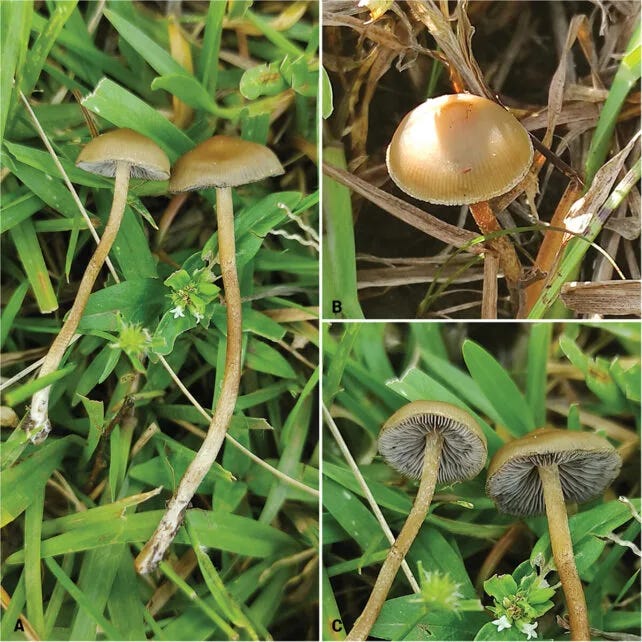Two New Species of Psilocybe Have Been Discovered
Until now, only four species of Psilocybe mushrooms have been discovered in Africa. Numbers five and six were discovered within the past year — Psilocybe ingeli and Psilocybe maluti.
The Psilocybe genus is home to some of our favorite psychedelic mushrooms — Psilocybe cubensis (the easiest to grow), Psilocybe semilanceata (the easiest to find), and Psilocybe azurescens (the strongest).
There are more than 120 different species of psychedelic mushrooms spread across six separate genera.
Today, we’re pleased to introduce two brand new South African shroom species — Psilocybe ingeli and Psilocybe maluti.
Resident mycologists discovered these species growing on cow manure and manure-enriched soils in two different regions of the country.
Here's what we know so far…
Psilocybe ingeli (Zulu Caps)
Psilocybe ingeli was discovered in the Kwa-Zulu-Natal region of South Africa. The first sample was found growing in manure-enriched soil amongst the tightly-grazed grass of a cattle pasture.
Talan Moult — a self-taught mycologist — discovered the species in 2023 while studying fungi in the area. A sample of P. ingeli was sent to Breyten van der Merwe at the Stellenbosch University for DNA analysis and recording.
This species’ closest relative is Psilocybe keralensis — an Indian species. It differs slightly in appearance, size, and spore dimensions.
Psilocybe ingeli has small, convex (domed) caps that are caramel-brown in color. They have striations running vertically toward a slight nipple-like protrusion in the center. The gills are light grey and annexed (narrowly attached). From base to cap, the stipe is white to brown and stretches three to five centimeters in height.
This is the fifth indigenous Psilocybe species to be discovered in Africa.
Psilocybe maluti (Lesothoan Rockets)
Psilocybe maluti was discovered in the highlands of Lesotho — 400 to 500 miles from the Psilocybe ingeli site.
The first sample was found growing directly on cow manure in a highland cattle pasture in the Maluti mountain range. Its name was adopted from the region in which it was discovered.
Danielle Mulder originally discovered the species in 2021 in the Kingdom of Lesotho. She sent photos to Andrew Killian — one of South Africa’s leading mycologists — who sourced a sample and sent it to Stellenbosch University for analysis and recording.
The appearance of P. Maluti is incredibly unique. The mushrooms are small, ranging from three to five centimeters in height. The caps are cream-colored, cone-shaped, and elongated.
They resemble tiny rockets erupting from the tightly-grazed grasslands of highland Lesotho.
The stems are broad and bright white, staining blue when bruised. The gills are purple-black, encapsulated inside the elongated cap.
This is the sixth indigenous Psilocybe species to be discovered in Africa.
The Traditional Use of Psilocybe maluti
Although this species was only recently recorded, anecdotal evidence suggests these little mushrooms have been used for centuries in Africa.
In a paper published in Mycologia detailing the discovery of P. maluti and P. ingeli, researchers presented information on the traditional use of the maluti mushrooms by Basotho healers in the Kingdom of Lesotho.
Although the traditional use of psilocybin mushrooms in Mesoamerica is widely documented, this is the first recorded evidence of their use in Africa. The natives of the Lesotho region have likely been using psilocybin mushrooms for hundreds, if not thousands, of years.
According to the paper, the native Basotho healers use the mushrooms to “foresee the future,” enter trances during shamanic rituals, and provide spiritual healing. A psychoactive brew (mushroom tea) is made by collecting large quantities of Psilocybe maluti and steeping them in warm water. Another native psychoactive plant known locally as “seipone” (Boophone disticha) is also sometimes added.
The potent psychedelic tea is consumed by patients who are then sat in front of a reflective surface. The patient is asked to relay information about the hallucinations they see in the reflection. The healer interprets these visions and provides spiritual advice based on them.
This exciting report provides insight into the previously unknown traditional mushroom culture in Sub-Saharan Africa. The exposure of this traditional practice will likely lead to further investigation in the region, hopefully revealing more about the ancient use of psilocybin mushrooms on the continent.
The Future of African Mycology: What Do These Discoveries Mean for Africa?
Just six species of Psilocybe mushrooms have been discovered and scientifically recorded in Africa so far. Dozens more unique species likely thrive on the continent.
The discovery of Psilocybe ingeli and Psilocybe maluti will, hopefully, encourage future mycological exploration in the region.
Just a year ago, a student in South Africa discovered a new, non-psychoactive species of fungi closely related to lion’s mane mushrooms in 2023 (named Hericium ophelieae).
Breyten van der Merwe from Stellenbosch University had this to say about it:
“These two species were sent to me by citizen scientists. It would be impossible for a single researcher to cover a fraction of an area these mushroom enthusiasts have access to. This is the only way we will be able to further studies in African mycology."
Van der Merwe is encouraging amateur mycologists to go in search of new fungi species in the region.
Could the next super-potent psilocybin-containing mushroom be discovered growing amongst the dramatic flora and fauna of Africa?
Want to Learn More About Psilocybin Mushrooms?
If this read inspired you to learn more about the fascinating world of fungi, check out these articles:
Enjoying the Trip? 🍄
Don’t Journey Alone! Tripsitter was built by a community of psychedelic advocates — but it’s people like you that allow us to thrive.








